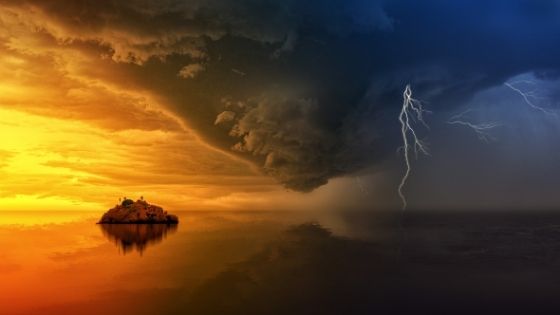Cyclones, hurricanes, typhoons and the like are natural weather systems that develop over warm water. They move slowly to the east or west over water, causing heavy rain and destructive winds. The track of these large cyclones can be challenging to follow, as they move along a generally warm surface-water temperature plane for much of their life. In recent years, computer models have been developed to forecast the paths of these weather systems and help forecasters determine where and when to most effectively send weather resources to meet the threat presented by a potential storm.
Cyclon Tracy – A category five monster
Cyclone Tracy was one of these extreme precipitation events in Australia from 1974 to 1975. Cyclone Tracy is now known as one of the most intense cyclones to ever strike Australia. Its maximum intensity was about 950 mBar, with wind speeds intensities exceeding 200 kilometres per hour. It was one of the strongest tropical cyclones to hit Darwin, Northern Australia.
Similar to other tropical storms or hurricanes, cyclones can cause flooding, mudslides, and flash flooding. Cyclone names derive from specific conditions that characterized the cyclone. Hurricane Tracy, which formed near the city of Darwin in Australia, caused immense destruction, displaced over 40 per cent of Darwin’s population, and killed over 60 people.
Like other tropical cyclones, Hurricane Tracy was formed as a low-pressure system moving across the ocean’s surface. It became a cyclone when it reached an area where the trade winds were blowing against its core. It was quite similar to other tropical cyclones and hurricanes in terms of top airflows, shear and texture in structure. It contained Category 5 wind speeds and generated intense rainfall – totals of up to 15 inches were reported. Furthermore, the storms impacted Australia in January and February with torrential rains.
Cyclonic weather cells are rotating disks of air that generate wind speeds exceeding thirty miles per hour. These weather systems are named tropical cyclones because they typically form during periods of tropical weather in which the warm front is displacing the warm and humid air by moving slowly eastwards into the colder northern hemisphere. The precipitation that falls from these storms has the same characteristics as any other tropical storm or hurricane. Its rate of descent is faster than the rain moving in, and the storm develops along with the coastal areas with warmer water.
Like other tropical cyclones, cyclone Tracy has a low-pressure center. Although the western Caribbean and the southwestern United States have seen significant rainfall over the last few months, none of these storms has made landfall. This may be because the strongest storms have passed over land rather than over water, thus not generating surface moisture sufficient to support heavy rainfall. Also, some models continue to show a lack of vertical lift over the tropical storms.
Cyclones create surges in water levels associated with precipitation that can exceed six feet. Heavy rain accompanied by strong winds can also generate further surges that reach one foot. A lack of clear skies and adequate warning time can make tropical cyclones more dangerous than other storms. Hurricane warnings are issued by the National Weather Service in collaboration with other federal and state weather resources. A hurricane warning is given once a tropical storm, together with associated signs and indicators, is expected to be near land. Forecasters use these signs to determine the progress of the storm and the probability of landfall.
Strongest Hurricanes and Cyclones
The strongest Atlantic hurricanes are named in a naming convention, such as alphabetically. Hurricane Hugo, a category 5 magnitude eyewall killed over 60 people in the 1980s. There have been several other names for eyewall tropical cyclones, including “Rita”, “Tip”, and “Wilma” and the Australian cyclone “Yasi”. Yasi was actually a stronger than typical tropical cyclone and generated a record rainfall over portions of North Queensland in Australia. Its sheer size and strength make it one of the most powerful tropical cyclones to ever strike the Australian mainland. It was a category 5 weather system.
Some Weather Facts
Have you ever wondered what the weather is like outside your window? If you have ever lived in a climate where rain showers and sunshine are the norms, you probably wonder what the weather is like outside your home on a sunny, rainy day. The answer may surprise you. The weather is unpredictable!
Although many climate models successfully predict clouds’ formation, the actual precipitation, clouds, and rainfall are challenging to determine. Historical precipitation records have shown that any weather event’s precipitation depends on what kind of clouds are present.
There are some situations where clouds can significantly impact the precipitation – such as when clouds are located in low-lying areas that can reduce the amount of precipitation or when clouds are near or overcast.
Cloudiness can also have a significant impact on the weather. A distinctively cold front can form as a result of heavy rainfall, increasing the likelihood of clouds to develop. To determine what kind of clouds are present, an analysis of the precipitation history should be performed – specifically, comparing cloudiness or clearness in precipitation patterns from different periods.
By combining historical precipitation with current knowledge about clouds, an artist can create a picture of what the weather is likely to be like for the next hour, day, week, or month. This technique called “radar imaging” is currently being used by the government to forecast severe weather and predict tornado paths.
Clouds can appear in several different forms. In a cloud, there are typically at least two (or more) layers of clouds. Most cloud formations are seen as ice crystals, and these crystals are usually lighter colored than their surroundings clouds. A cloud condensation can form on top of a cloud, which can increase the temperature of the layer of clouds and reduce the humidity and the dew point, a saturation level that the clouds reach after evaporating.
One of the best ways to visualize cloud formation is to view the precipitation – droplets of water – that you would see on your digital rain gauge as it passes over a cloud. The shape and size of the droplets can reveal a great deal about the structure of the cloud. Generally larger cloud sizes (drum sizes) produce warmer rain, while smaller cloud sizes produce cooler temperatures.
Understanding the relationship between cloud type and precipitation can help forecasters predict the weather in much the same way that they predict tornadoes and thunderstorms.
In addition to studying the visible characteristics of clouds, scientists and meteorologists study other physical characteristics of clouds. These include the composition of clouds (e.g., the fraction of cloud matter, different types of crystals, etc. ), cirrus properties, cloud movement, snowfall, cloud composition, wind speed and direction, and more. Understanding how different types of clouds interact with the atmosphere is essential for predicting the weather.
Researchers understand that clouds profoundly affect the atmosphere and how it may change throughout the day. However, they are still learning much about how clouds influence the weather. Understanding the science of how the weather is produced in the earth’s atmosphere is a vital piece of the puzzle to long-term weather forecasts.




















